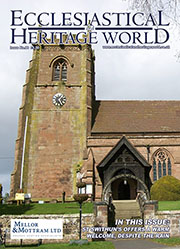NHIG launches Membership Directory
 The National Heritage Ironwork Group (NHIG) have recently launched an online Members Directory, providing a valuable resource for those seeking suitable contractors who subscribe to the organisation's Conservation Principles.
The National Heritage Ironwork Group (NHIG) have recently launched an online Members Directory, providing a valuable resource for those seeking suitable contractors who subscribe to the organisation's Conservation Principles.
Associations and organisations can also become members, and the National Heritage Training Group (NHTG) have recently joined the ranks in recognition of their common aims and shared goals.
The NHIG was established in 2009 by a group of experienced professionals from a broad range of related fields. Together they recognised that due to the sheer quantity of architectural wrought ironwork within the heritage sector there was a need for:
- A representative body
- A focal point for the discussion and dissemination of information
- A reference point for expertise or consultation
- Training routes for professionals
NHIG was set up with the objective of providing these and is currently leading the way worldwide in creating a representative body for the conservation of heritage ironwork through discussion, formalisation, lobbying and distribution of information.
Why is ironwork at risk?
Heritage ironwork is currently at risk because:
- It is an overlooked and undervalued part of the nation’s heritage
- It is under-represented in terms of education and standards
- It is not recognised as a skilled and specialist area of conservation
This is amply demonstrated by the lack of education or training combined with an absence of standards or regulation. The result is that it is commonplace for unqualified people to undertake renovation works leading to the inevitable consequence of irrevocable damage, or in severe cases even destruction, of artefacts through ignorance.
How has this happened?
A century ago blacksmith-made architectural wrought ironwork was a common and important part of our built environment. Used for anything from the most flamboyant displays to adorn stately homes to the commonplace simplicity of parkland railings. Altogether this has left us with a precious collection of heritage ironwork displaying a mastery of design and superb craftsmanship with many items being listed, often at the highest grades. Yet since the world wars there has been a steady decline in the size and condition of the nation’s ironwork mainly affected by:
- Lack of maintenance to address natural corrosion
- Changing fashions whereby decorative ironwork is not the preferred choice
- Financial preference for cheaper alternative options
- Lack of skill with traditional craftsmanship being replaced by modern fabrication methods
By acting now NHIG believes the decline can be stabilised and a sustainable future created to re-address the current situation.
How the NHIG helps
In achieving NHIG’s purpose of ensuring the conservation of ironwork for the benefit of the nation NHIG’s work can be categorised into the following areas of activity:
- Education: developing and sustaining individual and collective knowledge
- Research: instigating, conducting and publishing research about heritage ironwork
- Professional Standards: defining and promoting high standards in the care of heritage ironwork
- Resources: a focal point for information
- Advocacy: championing heritage ironwork within the conservation community and outside it, in public and private sectors, nationally and internationally
With the field of heritage ironwork being wide open, there is no shortage of work within the remit of the NHIG, resulting in many strands to their ambitions.
















